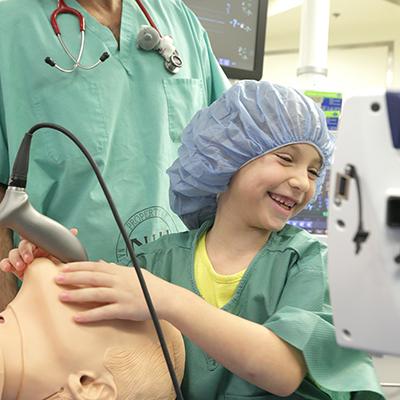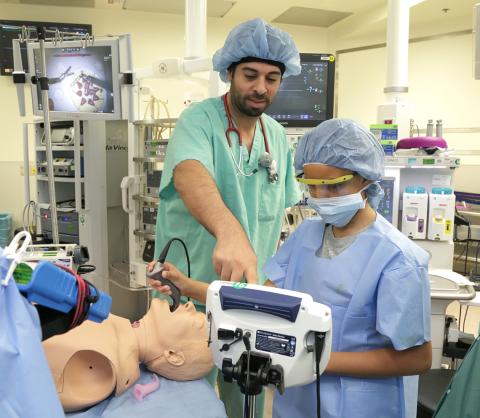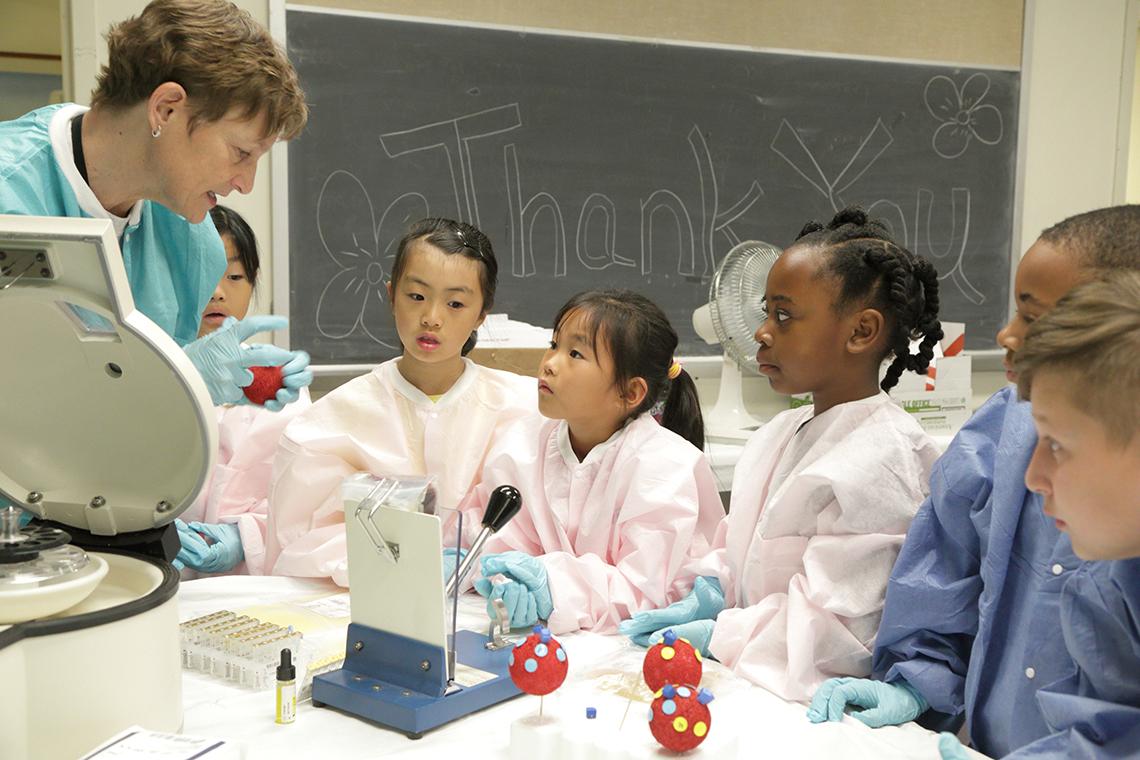TYCTWD Captivates Throngs of Eager Kids

Photo: Bill Branson, Ernie Branson
Hundreds of smiling kids descended on NIH on Apr. 28, excited to learn more about the place where their parents/guardians work. The 21st Take Your Child to Work/Earth Day featured dozens of activities both on and off campus that got kids thinking about ways to protect their health and the environment.
There were activities to stimulate all the senses. Some kids held models of hearts; others touched a preserved human brain. Some kids peered at cells through microscopes while others tried out gadgets that tested hearing and vision. Many kids and parents tasted farm-fresh cooking during an Earth Day demo. Throughout the day, the smell of curiosity was in the air.
Weeks earlier, many parents went online to register their kids for the limited-space activities, but a few of the most popular events filled up within minutes after being posted. One parent likened the process to trying to get Springsteen tickets.

Photo: Bill Branson, Ernie Branson
One of the most coveted events is the Clinical Center’s operating room, where the little apprentices put on scrubs and headed for surgery. They moved robotic arms to reach for paper clips and intubated a dummy patient.
Another popular annual event is Fantastic Voyage, where kids circulate among five stations to learn about blood and other cells. At the microbiology table, kids saw staph, strep, E. coli and other bacteria in Petri dishes and viewed parasites through a microscope. At phlebotomy, kids learned about bloodwork. “Don’t be scared,” said Michael Guyah, a technician in the CC’s department of laboratory medicine. “We look at your blood so the doctor knows how to treat you and make your ouchies go away.”

Photo: Bill Branson, Ernie Branson
In the CC’s audiology clinic, kids visited the sound isolation booth, charted pitch on an audiogram and took hearing tests. In a lab around the corner, kids tested their balance on a moving platform called computerized dynamic posturography.
“Your eyes and inner ears are connected,” said NIDCD research audiologist Dr. Chris Zalewski, while handing a child video goggles to try out. “Your vestibular system and eyes work together. Your eyes move when you turn your head or spin around so we can see how well your vestibular system senses movement by looking at how your eyes move.”

Photo: Bill Branson, Ernie Branson
If you’re born with a vestibular system that doesn’t work properly, you could still learn to ride a bike, Zalewski explained, but it would be much harder. “We can learn to balance without a normal vestibular system, but we cannot restore hearing once it’s lost,” he said, “so it’s very important to protect our hearing.”
Over in Bldg. 1, Dr. Michael Lauer, NIH deputy director for extramural research and a cardiologist, took out a 3-dimensional heart model and a bunch of stethoscopes. Kids excitedly jumped in to listen to their heartbeat and learn about this vital organ.
Off campus, more than 100 kids participated in the NIDA-NIMH Brain Science Fair in the Neuroscience Research Center. The kids saw and touched preserved human and animal brains, viewed brain cells through microscopes and participated in other activities.
“My favorite event was the tour of the mouse facility [in the Clinical Center], because we got to see, like, 14 pinkies,” said 8-year-old Caleb Olander. “Pinkies are baby mice and they are super cute. We got to learn how the staff take care of the mice.”
Other activities showed youngsters how to burn off steam, from exercising to creating art. In the fitness center, group classes included CrossFit and jungle yoga. Fitness instructor Ashley Kim led a session called POUND, during which each kid used a pair of drumsticks, adding rhythm to their workout.
Children also learned about stress relief during NHLBI’s origami event in Bldg. 31. While some events required parents to wait outside, NHLBI encouraged parents and kids to participate together. Through coloring and the Japanese art of paper-folding known as origami, kids and parents were reminded to make time for stress-reducing activities. What else helps reduce stress? Some cited listening to music and playing outside; parents said shopping and sleep.
“We don’t need highly technical gadgets for people to understand something is healthy for them,” said NHLBI’s Kim Copenhaver. “It’s important at this age to think about healthy things to create balance in our lives.”

Photo: Bill Branson, Ernie Branson
The day also featured open events without a space limit. Hundreds of kids met service dog Charlie and enjoyed the ever-popular NIH Police demonstration on the Bldg. 31 patio.
Many kids enjoyed playing interactive games. NIBIB had iPads set up for kids to play Want to Be a Bioengineer? “Science and communications folks worked to make it mobile-friendly and educational,” said NIBIB’s Dr. Tom Johnson. In the CC south lobby and off campus in Rockledge, budding scientists tried out another game app called NIH Scientist, where they learned about research to fight disease, even how to get a research grant.
Mother Nature sent heavy rain that day, so Earth Day activities moved indoors to the Natcher Bldg. Kids and parents roamed the hallways, learning ways to conserve, compost and cultivate. Many kids posted promises to protect the environment on a Pledge Tree. These included taking shorter showers and turning off lights and the Xbox when not in use.
Professional chef and food educator Jonathan Bardzik prepared quinoa with asparagus and a vinaigrette, which kids and parents happily sampled while learning about sustainable cooking. Winding through the corridor, kids and parents learned about climate change, home and workplace safety and how to grow their own bonsai trees. Many kids received plant seedlings to help start their own garden. NIH’s Department of Environmental Protection staff talked about NIH green initiatives, from rooftop solar panels to more plugs to power electric cars. The R&W collected used eyeglasses and cell phones for donation. And the big paper shredder truck was out back, inspiring moms and dads to clean out their offices.
It was another successful Take Your Child to Work/Earth Day that informed and entertained both kids and parents alike. If you missed out on getting a spot for your child in a reserved event that filled up fast, there’s always next year. Just remember to sign up early. To see more images from the day, visit the NIH Record online.




